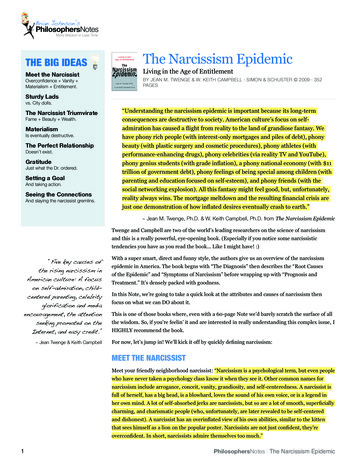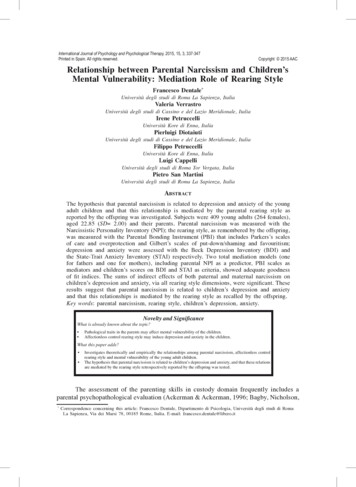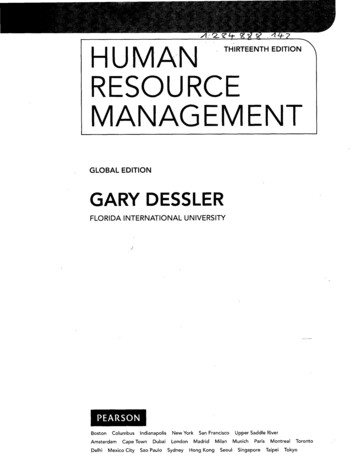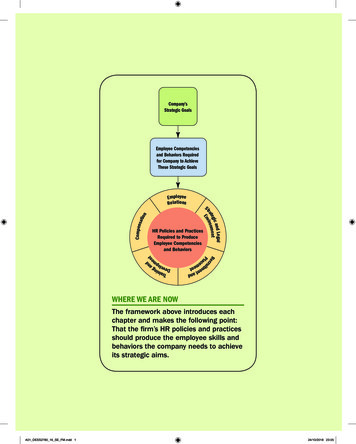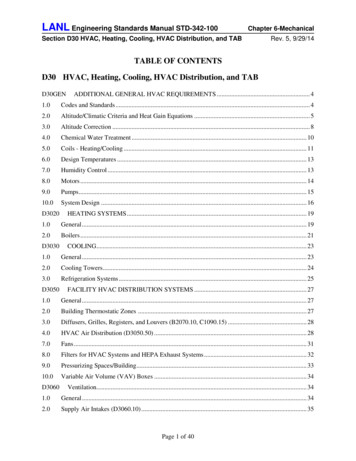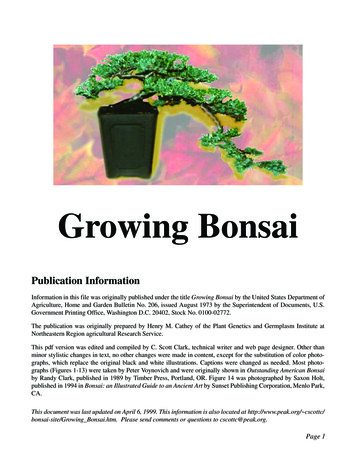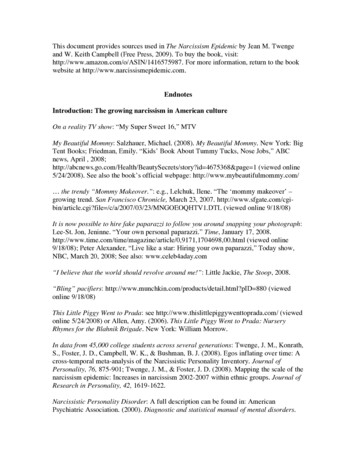
Transcription
This document provides sources used in The Narcissism Epidemic by Jean M. Twengeand W. Keith Campbell (Free Press, 2009). To buy the book, visit:http://www.amazon.com/o/ASIN/1416575987. For more information, return to the bookwebsite at tion: The growing narcissism in American cultureOn a reality TV show: “My Super Sweet 16,” MTVMy Beautiful Mommy: Salzhauer, Michael. (2008). My Beautiful Mommy. New York: BigTent Books; Friedman, Emily. “Kids’ Book About Tummy Tucks, Nose Jobs,” ABCnews, April , ory?id 4675368&page 1 (viewed online5/24/2008). See also the book’s official webpage: http://www.mybeautifulmommy.com/ the trendy “Mommy Makeover.”: e.g., Lelchuk, Ilene. “The ‘mommy makeover’ –growing trend. San Francisco Chronicle, March 23, 2007. http://www.sfgate.com/cgibin/article.cgi?file /c/a/2007/03/23/MNGOEOQHTV1.DTL (viewed online 9/18/08)It is now possible to hire fake paparazzi to follow you around snapping your photograph:Lee-St. Jon, Jeninne. “Your own personal paparazzi.” Time, January 17, 171,1704698,00.html (viewed online9/18/08); Peter Alexander, “Live like a star: Hiring your own paparazzi,” Today show,NBC, March 20, 2008; See also: www.celeb4aday.com“I believe that the world should revolve around me!”: Little Jackie, The Stoop, 2008.“Bling” pacifiers: http://www.munchkin.com/products/detail.html?pID 880 (viewedonline 9/18/08)This Little Piggy Went to Prada: see http://www.thislittlepiggywenttoprada.com/ (viewedonline 5/24/2008) or Allen, Amy. (2006). This Little Piggy Went to Prada: NurseryRhymes for the Blahnik Brigade. New York: William Morrow.In data from 45,000 college students across several generations: Twenge, J. M., Konrath,S., Foster, J. D., Campbell, W. K., & Bushman, B. J. (2008). Egos inflating over time: Across-temporal meta-analysis of the Narcissistic Personality Inventory. Journal ofPersonality, 76, 875-901; Twenge, J. M., & Foster, J. D. (2008). Mapping the scale of thenarcissism epidemic: Increases in narcissism 2002-2007 within ethnic groups. Journal ofResearch in Personality, 42, 1619-1622.Narcissistic Personality Disorder: A full description can be found in: AmericanPsychiatric Association. (2000). Diagnostic and statistical manual of mental disorders.
4th ed., text revision. Washington: American Psychiatric Association. See also: Miller, J.D. & Campbell, W. K. (2008). Comparing clinical and social-personalityconceptualizations of narcissism. Journal of Personality, 76, 449-476.Nearly 1 out of 10 of Americans in their twenties, and 1 out of 16 of those of all ages, hasexperienced the symptoms of NPD: Stinson, F. S., Dawson, D. A., Goldstein, R. B.,Chou, S. P., Huang, B., Smith, S. M., Ruan, W. J., Pulay, A. J., Saha, T. D., Pickering, R.P., & Grant, B. F. (2008). Prevalence, correlates, diability, and comorbidity of DSM-IVNarcissistic Personality Disorder: Results from the Wave 2 National EpidemiologicSurvey on Alcohol and Related Conditions. Journal of Clinical Psychiatry, 69, 10331045.former presidential candidate John Edwards explained his extramarital 2405.html (viewed online 9/18/08)narcissism “has become the go-to diagnosis ”: Hoffman, Jan. “Here’s looking at me,kid,” New York Times, July 20, 2008. Archived as “Everyone’s Narcissistic, It Seems.” the number of teens getting breast augmentations jumped 55%: Numbers, Time, March24, 2008, p. 19. Source: American Society for Aesthetic Plastic SurgeryRoger Kimball in The New Criterion: cited in West. Diana. (2008). The Death of theGrown-Up. New York: St. Martin’s Press. p. xii.Chapter 1: The Many Wonders of Admiring Yourself (and notes for Appendix A)Self-esteem is at an all-time high, with more than 80% of recent college students scoringhigher in general self-esteem than the average late 1960s Baby Boomer college student:Twenge, J. M., & Campbell, W. K. (2001). Age and birth cohort differences in selfesteem: A cross-temporal meta-analysis. Personality and Social Psychology Review, 5,321-344; Gentile, B., & Twenge, J. M. Birth cohort changes in self-esteem, 1988-2007.Unpublished manuscript. Based on: Gentile, B. (2008). Master’s thesis, San Diego StateUniversity.Middle school students, often the focus of self-esteem boosting efforts, have skyrocketedin self-esteem: Twenge, J. M., & Campbell, W. K. (2001). Age and birth cohortdifferences in self-esteem: A cross-temporal meta-analysis. Personality and SocialPsychology Review, 5, 321-344; Gentile, B., & Twenge, J. M. Birth cohort changes inself-esteem, 1988-2007. Unpublished manuscript. Based on: Gentile, B. (2008). Master’sthesis, San Diego State University.More high school seniors now report that they are satisfied with themselves (3 out of 4,compared to 2 out of 3 in 1975: Twenge, J. M. & Campbell, W. K. (in press). Increases inpositive self-views among high school students: Birth cohort changes in anticipatedperformance, self-satisfaction, self-liking, and self-competence. Psychological Science.
Younger generations are also markedly higher in other traits related to self-admiration,including individualism, assertiveness, and extraversion: Twenge, J. M. (1997). Changesin masculine and feminine traits over time: A meta-analysis. Sex Roles, 36, 305-325;Twenge, J. M. (2001a). Birth cohort changes in extraversion: A cross-temporal metaanalysis, 1966-1993. Personality and Individual Differences, 30, 735-748; Twenge, J. M.(2001b). Changes in women’s assertiveness in response to status and roles: A crosstemporal meta-analysis, 1931-1993. Journal of Personality and Social Psychology, 81,133-145. college-educated women born in the 1930s grew increasingly focused on theirindividual selves as they lived through the indulgent decades of the 1960s, 1970s, and1980s: Roberts, B. W., & Helson, R. (1997). Changes in culture, changes in personality:The influence of individualism in a longitudinal study of women. Journal of Personalityand Social Psychology, 72, 641-651.As an NBC public service announcement puts it, “You may not realize it, but everyone isborn with their one true love – themselves. If you like you, everyone else will too.”:http://www.themoreyouknow.com/Self Esteem/ (viewed online 6/3/2008)“God wants us to have healthy, positive self-images, to see ourselves as pricelesstreasures,”: Osteen, Joel. (2004). Your Best Life Now: 7 Steps to Living at Your FullPotential. New York: Warner Faith. p. 57.Self-esteem is considered, as one author put it, our “national wonder drug.”:Kaplan, L. S. (1995). Self-esteem is not our national wonder drug. School Counselor, 42,341-345.Chidi Ogbuta of Allen, Texas, certainly admires herself: When she got married, herwedding cake was in the shape of herself: The image can be found ndex.html (viewed online 6/3/2008).At the 2003 ESPY Awards, Denver Nuggets basketball player Carmelo Anthony thankedhimself for all the hard work he’d put 8.htmlIn 2004, football player Freddie Mitchell, who caught a touchdown pass in a playoffgame, was also grateful to himself, saying, “I’m a special player and I just want to thankmy hands for being so te/21683474/Ashley Tisdale, who drew fire for a different-looking nose after what she said wassurgery for a deviated septum, “I don’t believe in plastic surgery ”O’Leary, Kevin. “Ashley’s nose drama.” Us Weekly, December 31, 2007.
Ashlee Simpson, who also had a nose job, said that plastic surgery “should be foryourself.”Ibid.Hilary Duff echoed this sentiment: “Facing off over plastic surgery,” People, October 18,2004.Lohan declared herself “a role model to younger generations as well as generationsolder than me”:“Lindsay’s words of wisdom,” Us Weekly, December 25, 2006.“If I wanted to get in better shape, there might be a backlash of, ‘Why isn’t shecomfortable with herself anymore?’”: “Cover stars: America Ferrera,” Us Weekly,September 17, 2007.“one of your most important gifts as a parent is to help your child develop self-esteem.”:Shelov, Steven. [Editor-in-Chief.] (1998). Caring for your baby and young child: Birth toage 5. New York: Bantam Books.In a recent study of the mothers and grandmothers of 3-year-old American children:Cho, G. E., Sandel, T. L., Miller, P. J., & Wnag, S. (2005). What do grandmothers thinkabout self-esteem? American and Taiwanese folk theories revisited. Social Development,14, 701-721.Chapter 2: Diagnosing Narcissism: The Disease of Excessive Self-Admiration (andnotes for Appendix B)People with high levels of narcissism – whom we refer to as “narcissists” – think theyare better than others in many areas, including social status, good looks, intelligence,and creativity: Campbell, W. K., Rudich, E., & Sedikides, C. (2002). Narcissism, selfesteem, and the positivity of self-views: Two portraits of self-love. Personality andSocial Psychology Bulletin, 28, 358-368; Gabriel, M. T., Critelli, J. W., & Ee, J. S.(1994). Narcissistic illusions in self-evaluations of intelligence and attractiveness.Journal of Personality , 62, 143-155. . . they are special, entitled, and unique: Campbell, W. K., Bonacci, A. M., Shelton, J.,Exline, J. J., & Bushman, B. J. (2004). Psychological entitlement: Interpersonalconsequences and validation of a new self-report measure. Journal of PersonalityAssessment, 83, 29-45; Emmons, R. A. (1984). Factor analysis and construct validity ofthe Narcissistic Personality Inventory. Journal of Personality Assessment, 48, 291-300.Narcissists also lack emotionally warm, caring and loving relationships with otherpeople. The emotional connection to others isn’t there or is very muted: Foster, J.D.,Shrira, I., & Campbell, W. K. (2006). Theoretical models of narcissism, sexuality, andrelationship commitment. Journal of Social and Personal Relationships, 23, 367-386;
Campbell, W. K., Foster, C. A., & Finkel, E. J. (2002). Does self-love lead to love forothers? A story of narcissistic game playing. Journal of Personality and SocialPsychology, 83, 340-354; Carroll, L. (1987). A study of narcissism, affiliation, intimacy,and power motives among students in business administration. Psychological Reports,61, 355-358.One approach is to simply use other people as pawns in a grand game of deception:Campbell, W. K. & Foster, J. D. (2007). The Narcissistic Self: Background, an ExtendedAgency Model, and Ongoing Controversies. In C. Sedikides & S. Spencer (Eds.),Frontiers in social psychology: The self (pp. 115-138). Philadelphia, PA: PsychologyPress; Campbell, W. K., Brunell, A. B, & Finkel, E. J. (2006). Narcissism, interpersonalself-regulation, and romantic relationships: An Agency Model approach. In E. J. Finkel &K. D. Vohs (Eds.) Self and Relationships: Connecting Intrapersonal and InterpersonalProcesses. (pp. 57-83). New York: Guilford; Campbell, W. K., & Green, J. D. (2007).Narcissism and interpersonal self-regulation. In J. V. Wood, A. Tesser, & J. G. Holmes(Eds.). Self and Relationships (pp. 73-94). New York: Psychology Press.They brag about their achievements (while blaming others for their shortcomings):Campbell, W. K., Reeder, G. D., Sedikides, C., & Elliot, A. J. (2000). Narcissism andcomparative self-enhancement strategies. Journal of Research in Personality, 34, 329347; Buss, D. M., & Chiodo, L. M. (1991). Narcissistic acts in everyday life. Journal ofPersonality, 59, 179-215; Rhodewalt, F., & Morf, C. C. (1996). On self-aggrandizementand anger: A temporal analysis of narcissism and affective reactions. Journal ofPersonality and Social Psychology, 74, 672-685. . . focus on their physical appearance: Robins, R. W., & John, O. P. (1997). Effects ofvisual perspective and narcissism on self-perception: Is seeing believing? PsychologicalScience, 8, 37–42. . . talk with a loud voice, use big gestures, constantly turn the conversation back tothemselves: Buss, D. M., & Chiodo, L. M. (1991). Narcissistic acts in everyday life.Journal of Personality, 59, 179-215; Vangelisti, A., Knapp, M. L., & Daly, J. A. (1990).Conversational narcissism. Communication Monographs, 57, 251-274. . . manipulate and cheat to get ahead: Blickle, G., Schlegel, A., Fassbender, P., & Klein,U. (2006). Some personality correlates of business white-collar crime. AppliedPsychology: An International Review, 55, 220-233; Nathanson, C., Paulhus, D. L., &Williams, K. M. (2006). Predictors of a behavioral measure of scholastic cheating:Personality and competence but not demographics. Contemporary EducationalPsychology, 31, 97-122. The effect in the latter study is small, with a d of roughly 18. . . seek out “trophy partners” who make them look good: Campbell, W. K. (1999).Narcissism and romantic attraction. Journal of Personality and Social Psychology, 77,1254-1270.
. . . and jump at opportunities to garner attention and fame. Wallace, H. M., &Baumeister, R. F. (2002). The performance of narcissists rises and falls with perceivedopportunity for glory. Journal of Personality and Social Psychology, 82, 819-834.Researchers have labeled these efforts to gain self-admiration “self-regulationstrategies.”: Morf, C. C., & Rhodewalt, F. (2001). Unraveling the paradoxes ofnarcissism: A dynamic self-regulatory processing model. Psychological Inquiry, 12, 177196. (This entire issue of Psychological Inquiry is a great read for those interested in selfregulatory models of narcissism.)When it works, the narcissist feel a rush of esteem and pride: Baumeister, R. F., & Vohs,K. D. (2001). Narcissism as addiction to esteem. Psychological Inquiry, 12, 206-210. . . when it fails, the narcissist reacts with anger, blame, and sometimes rage. Bushman,B. J., & Baumeister, R. F. (1998). Threatened egotism, narcissism, self-esteem, and directand displaced aggression: Does self-love or self-hate lead to violence? Journal ofPersonality and Social Psychology, 75, 219-229. This is the classic article on this topic.Both authors have done more in the area, as have others like Kirkpatrick, Konrath,Rhodewalt, Stucke, and Webster.Narcissistic Personality Inventory (NPI): The most commonly used version of the NPI isreported in Raskin, R. N., & Terry, H. (1988). A principle components analysis of theNarcissistic Personality Inventory and further evidence of its construct validity. Journalof Personality and Social Psychology, 54, 890-902. See also Emmons, R. A. (1984).Factor analysis and construct validity of the narcissistic personality inventory. Journal ofPersonality Assessment, 48, 291-300. Raskin, R. N., & Hall, C. S. (1979). A narcissisticpersonality inventory. Psychological Reports, 45, 590. Raskin, R. N., & Hall, C. S.(1981). The narcissistic personality inventory: alternate form reliability and furtherevidence of construct validity. Journal of Personality Assessment, 45, 159–162. There areseveral shorter versions of the scale also available as well as various assessments of thefactor structure. . . the personality trait of narcissism lies along a continuum: Foster, J. D. & Campbell,W. K. (2007). Are there such things as “narcissists” in social psychology? A taxometricanalysis of the Narcissistic Personality Inventory. Personality and Individual Differences,43, 1321-1332.For example, author Michael Maccoby praises business leaders he calls “productivenarcissists.”: Maccoby, M. (2007). Narcissistic leaders: Who Succeeds and Who Fails.Cambridge: Harvard Business School Press; Maccoby, M. (2000). Narcissistic leaders:The incredible pros, the inevitable cons. Harvard Business Review, 68-77.In fact, many researchers have argued just the opposite, that narcissists lack self-controland perseverance: This is a complex issue, but the evidence does support a link betweennarcissism and approach orientation and sensation-seeking, as well as certain impulsivebehaviors that go with it. Foster, J. D., & Trimm IV, R. F. (2008). On being eager and
uninhibited: Narcissism and approach-avoidance motivation. Personality and SocialPsychology Bulletin, 34, 1004-1017; Miller, J. D., Campbell, W. K., Young, D. L.,Lakey, C. E., & Reidy, D. E., Zeichner, A., & Goodie, A. S. (in press). Examining therelations among narcissism, impulsivity, and self-defeating behaviors. Journal ofPersonality; Vazire, S., & Funder, D. C. (2006). Impulsivity and the self-defeatingbehavior of narcissists. Personality and Social Psychology Review, 10, 154-165.This interplay of short-term payoffs and long-term costs makes narcissism seductive tomany people: Campbell, W. K. & Buffardi, L. E. (2008). The lure of the noisy ego:Narcissism as a social trap. In J. Bauer & H. Wayment (Eds.), Quieting the ego:Psychological benefits of transcending egotism. Washington, DC: AmericanPsychological Association.Several researchers have argued that the clinical definition of narcissism captures twodifferent types of people: Cain N. M., Pincus, A. L., Ansell, E. B. (2008). Narcissism atthe crossroads: Phenotypic description of pathological narcissism across clinical theory,social/personality psychology, and psychiatric diagnosis. Clinical Psychology Review, 28,638-656; Miller, J. D. & Campbell, W. K. (2008). Comparing clinical and socialpersonality conceptualizations of narcissism. Journal of Personality, 76, 449-476. Theseare the two most recent articles, but there is a long debate surrounding this issue. Therehas also been a case made for three “types” of narcissism by researchers such as PaulWink and Drew Weston.A diagnostic manual used by some therapists breaks narcissism into these two types:Alliance of Psychoanalytic Organizations (2006). Psychodynamic diagnostic manual(PDM; 1st edition).“Love God, love yourself, love others – in that order. you have to feel good about whatGod has made you – what you look like, and so on. I don’t think you can showcompassion, be respectful and kind, if you can’t love yourself.”: Patrick Rogers andVickie Bane, “Joel Osteen counts his blessings,” People, December 17, 2007.After low self-esteem people learned they did poorly on a test, they were restrained andsubdued when talking to a new person, and came across as likeable and friendly:Heatherton, T. F., & Vohs, K. D. (2000). Interpersonal evaluations following threats toself: Role of self-esteem. Journal of Personality and Social Psychology, 78, 725-736;Vohs, K. D., & Heatherton, T. F. (2001). Self-esteem and threats to self: Implications forself-construals and interpersonal perceptions. Journal of Personality and SocialPsychology, 81, 1103-1118.Narcissists are even worse, often lashing out with aggression when they are challenged:Bushman, B. J., & Baumeister, R. F. (1998). Threatened egotism, narcissism, selfesteem, and direct and displaced aggression: Does self-love or self-hate lead to violence?Journal of Personality and Social Psychology, 75, 219-229.
Think about it this way: Did the cruelest dictators of history -- men like Stalin, Hitler, andPol Pot -- lack self-admiration?: Baumeister, R. F., Smart, L., & Boden, J. M. (1996).Relation of threatened egotism to violence and aggression: The dark side of high selfesteem. Psychological Review, 103, 5-33.Low self-esteem folks usually do just fine getting along with others: A few papers havefound a correlation between low self-esteem and antisocial behaviors [Donnellan, M. B.,Trzesniewski, K. H., Robins, R. W., Moffitt, T. E., & Caspi, A. (2005). Low self-esteemis related to aggression, antisocial behavior, and delinquency. Psychological Science, 16,328-335; Trzesniewski, K. H., Donnellan, M. B., Moffitt, T. E., Robins, R. W., Poulton,R., & Caspi, A. (2006). Low self-esteem during adolescence predicts poor health,criminal behavior, and limited economic prospects during adulthood. DevelopmentalPsychology, 42, 381-390.] However, more recent research found that these analyses wereflawed because they did not control for important factors such as family background andchild sexual abuse. When these variables are controlled, there is no correlation betweenself-esteem and negative outcomes such as aggression or drug abuse [Boden, J. M.,Fergusson, D. M., & Horwood, L. J. (2007). Self-esteem and violence: Testing linksbetween adolescent self-esteem and later hostility and violent behavior. Social Psychiatryand Psychiatric Epidemiology, 42, 881-891; Boden, J. M., Fergusson, D. M., &Horwood, L. J. (2008). Does adolescent self-esteem predict later life outcomes? A test ofthe causal role of self-esteem. Development and Psychopathology, 20, 319-339]. Anotherset of studies did several carefully controlled experiments on the relationship betweenself-esteem, narcissism, and aggression, and found that the most aggressive people werethose who were high in both self-esteem and narcissism: Bushman, B. J., Baumeister, R.F., Thomaes, S., Ryu, E., Begeer, S., & West, S. G. (in press). Looking again, and harder,for a link between low self-esteem and aggression. Journal of Personality.Especially after hearing bad news, people low in self-esteem seek connection with otherpeople and are seen as friendly. Heatherton, T. F., & Vohs, K. D. (2000). Interpersonalevaluations following threats to self: Role of self-esteem. Journal of Personality andSocial Psychology, 78, 725-736; Vohs, K. D., & Heatherton, T. F. (2001). Self-esteemand threats to self: Implications for self-construals and interpersonal perceptions. Journalof Personality and Social Psychology, 81, 1103-1118.Negative people tend to drive others away: There are several lines of research thatconverge on this conclusion, including those on interpersonal models of depression:Joiner, T. E. & Metalsky, G. I. (1995). A prospective test of an integrative interpersonaltheory of depression: A naturalistic study of college roommates. Journal of Personalityand Social Psychology, 69, 778–788; much of Sandra Murray and others’ work onrelationships and self-esteem/self-views: e.g., Murray, S. L., Holmes, J. G., & Griffin, D.W. (1996). The benefit of positive illusions: Idealization and the construction ofsatisfaction in close relationships. Journal of Personality and Social Psychology, 70, 7998; the literature on rejection sensitivity: Downey, G., & Feldman, S. I. (1996).Implications of rejection sensitivity for intimate relationships. Journal of Personality andSocial Psychology, 70, 1327-1343. For a review, see Campbell, W. K. & Baumeister, R.F. (2001). Is loving the self necessary for loving another? An examination of identity and
intimacy. In M. Clark & G. Fletcher (Eds.), Blackwell handbook of social psychology(Vol. 2): Interpersonal Processes. (pp. 437-456). London: Blackwell.Narcissists think they are smarter, better looking, and more important than others, butnot necessarily more moral, more caring, or more compassionate: Campbell, W. K.,Rudich, E., & Sedikides, C. (2002). Narcissism, self-esteem, and the positivity of selfviews: Two portraits of self-love. Personality and Social Psychology Bulletin, 28, 358368.close relationships keep the ego in check: Campbell, W. K., Sedikides, C., Reeder, G.D., & Elliot, A. J. (2000). Among friends?: An examination of friendship and the selfserving bias. British Journal of Social Psychology, 39, 229-239; Sedikides, C.,Campbell, W. K., Reeder, G. D., & Elliot, A. J. (1998). The self-serving bias in relationalcontext. Journal of Personality and Social Psychology, 74, 378-386.However, there is no evidence that the extraverted narcissists we focus on in this bookhave low self-esteem or are insecure underneath: This is a very complex topic. Severalresearchers recently completed a theoretical and meta-analytic review of the issues in thisand the following paragraphs: Bosson, J. K., Lakey, C. E., Campbell, W. K., Zeigler-Hill,V., Jordan, C. H., & Kernis, M. H. (2008). Untangling the Links Between Narcissism andSelf esteem: A Theoretical and Empirical Review. Social and Personality PsychologyCompass.Narcissistic people found it just as easy – or even easier – than non-narcissists to hit thekey for “me” when they saw words like good, wonderful, great, and right: Campbell, W.K., Bosson, J. K., Goheen, T. W., Lakey, C. E., & Kernis, M. H. (2007). Do narcissistsdislike themselves “deep down inside”? Psychological Science, 18, 227-229.Two studies found that narcissists didn’t score any higher on objective IQ tests: Gabriel,M. T., Critelli, J. W., & Ee, J. S. (1994). Narcissistic illusions in self-evaluations ofintelligence and attractiveness. Journal of Personality, 62, 143-155; Paulhus, D. L., &Harms, P. D. (2004). Measuring cognitive ability with the overclaiming.technique.Intelligence, 32, 297-314.another found no correlation between narcissism and performance on a test of generalknowledge: Campbell, W. K., Goodie, A. S., & Foster, J. D. (2004). Narcissism,confidence, and risk attitude. Journal of Behavioral Decision Making, 17, 297-311. Seealso Lakey, C. E., Rose, P., Campbell, W. K., & Goodie, A. S. (2008). Probing the linkbetween narcissism and gambling: The mediating role of judgment and decision-makingbiases. Journal of Behavioral Decision Making, 21, 113-137.Studies on creativity are mixed, with one finding a correlation and another finding norelationship: Raskin, R. N. (1980). Narcissism and creativity: Are they related?Psychological Reports, 46, 55-60; Brunell, A. B., Gentry, W., Campbell, W. K., &Kuhnert, K. (2006, January). Narcissism and emergent leadership. Poster presented at theannual meeting of the Society for Personality and Social Psychology, Palm Springs, CA.
Narcissists clearly aren’t any better looking: Across two studies, strangers who ratedtheir headshots found them no more attractive than others: Gabriel, M. T., Critelli, J. W.,& Ee, J. S. (1994). Narcissistic illusions in self-evaluations of intelligence andattractiveness. Journal of Personality, 62, 143-155; Bleske-Rechek, A., Remiker, M. W.,& Baker, J. P. (2008). Narcissistic men and women think they are so hot – But they arenot. Personality and Individual Differences. 45, 420-424. . . .the pictures narcissists chose for their personal webpages were rated as moreattractive by observers: Buffardi, L. E., & Campbell, W. K. (2008). Narcissism andsocial networking websites. Personality and Social Psychology Bulletin.we had people take a general knowledge test and then bet on their answers: Campbell,W. K., Goodie, A. S., & Foster, J. D. (2004). Narcissism, confidence, and risk attitude.Journal of Behavioral Decision Making, 17, 297-311.In another study, researchers asked questions about false pieces of knowledge: Paulhus,D. L., Harms, P. D., Bruce, M. N., & Lysy, D. C. (2003). The over-claiming technique:Measuring self-enhancement independent of ability. Journal of Personality and SocialPsychology, 84, 890-904.College students in the 2000s were significantly more narcissistic than GenXers andBaby Boomers in the 1970s, 1980s, and 1990s: Twenge, J. M., Konrath, S., Foster, J. D.,Campbell, W. K., & Bushman, B. J. (2008a). Egos inflating over time: A cross-temporalmeta-analysis of the Narcissistic Personality Inventory. Journal of Personality, 76, 875901; Twenge, J. M., Konrath, S., Foster, J. D., Campbell, W. K., & Bushman, B. J.(2008b). Further evidence of an increase in narcissism among college students. Journal ofPersonality, 76, 919-927; Twenge, J. M., & Foster, J. D. (2008). Mapping the scale of thenarcissism epidemic: Increases in narcissism 2002-2007 within ethnic groups. Journal ofResearch in Personality. 42, 1619-1622.Narcissism has risen as much as obesity has over the last few decades: The change innarcissism from 1979 to 2006 was .33 standard deviations. The Center for DiseaseControl reports that between the 1976-1980 data collection and the 1999-2002 datacollection, men’s Body Mass Index (BMI) rose from 25.6 to 27.8. With a pooled standarddeviation of 6.95, this is a change of .32 SDs. Women’s BMI rose from 25.3 to 28.2 witha pooled SD of 9.49, a change of .30 SDs. BMI is a better measure of overweight andobesity than weight alone, as height has also risen over this same time period. Ogden, C.L., Fryar, C. D., Carroll, M. D., & Flegal, K. M. (2004). Mean Body Weight, Height, andBody Mass Index, United States 1960-2002. Advance Data from Vital and HealthStatistics, 347, October 27. 2004. . .author Jake Halpern found that twice as many black as white teens said they’d ratherbe famous than be smarter, stronger, or more beautiful: Halpern, J. (2007). Fame junkiesThe hidden truths behind America’s favorite addiction. New York: Houghton Mifflin.
In an Internet study of NPI scores: Foster, J. D., Campbell, W. K., & Twenge, J. M.(2003). Individual differences in narcissism: Inflated self-views across the lifespan andaround the world. Journal of Research in Personality, 37, 469-486.Interestingly, rates of NPD are actually slightly higher among adults with lower incomes:Stinson, F. S., Dawson, D. A., Goldstein, R. B., Chou, S. P., Huang, B., Smith, S. M.,Ruan, W. J., Pulay, A. J., Saha, T. D., Pickering, R. P., & Grant, B. F. (2008).Prevalence, correlates, diability, and comorbidity of DSM-IV Narcissistic PersonalityDisorder: Results from the Wave 2 National Epidemiologic Survey on Alcohol andRelated Conditions. Journal of Clinical Psychiatry, 69, 1033-1045.In one dataset, Americans scored in the top 10-20% of nations on narcissism.Campbell, W. K., Miller, J. D., & Buffardi, L. E. (2008, October). Looking for theCulture of Narcissism. Talk presented at the Southeastern Society for Social Psychology,Greenville, SC.In another study, Americans obtained higher narcissism scores than those from any othercountry.Foster, J. D., Campbell, W. K., & Twenge, J. M. (2003). Individual differences innarcissism: Inflated self-views across the lifespan and around the world. Journal ofResearch in Personality, 37, 469-486.Another study, seemed to contradict: Trzesniewski, K. H., Donnellan, M.
narcissism epidemic: Increases in narcissism 2002-2007 within ethnic groups. Journal of Research in Personality, 42, 1619-1622. Narcissistic Personality Disorder: A full description can
